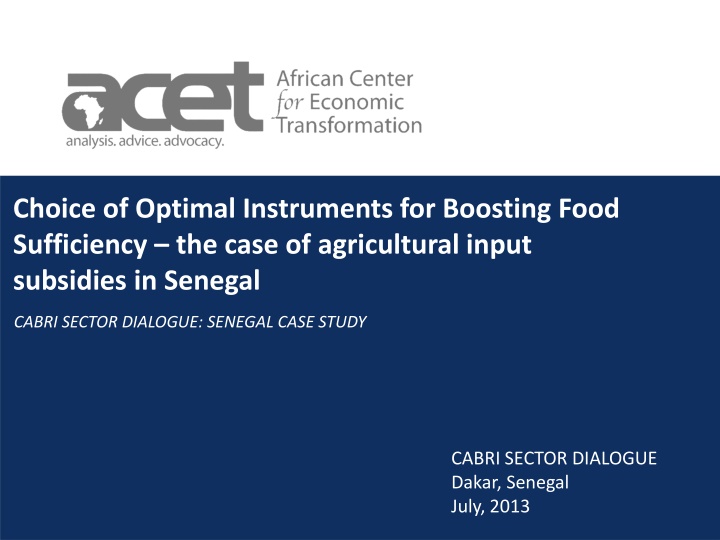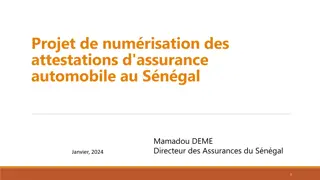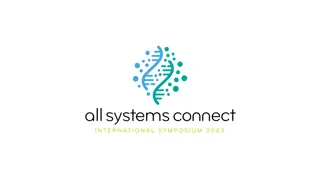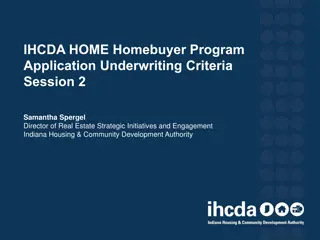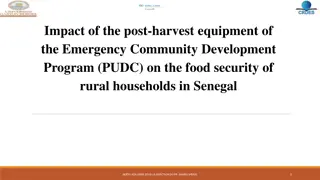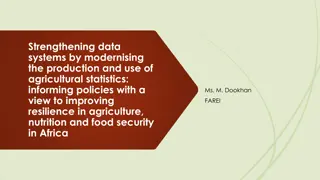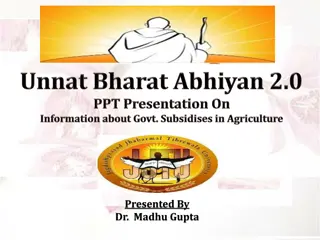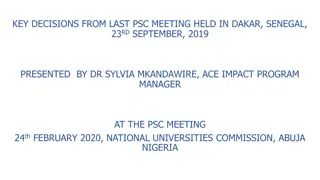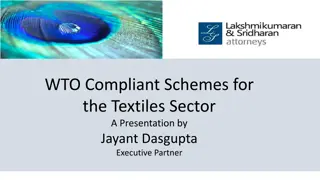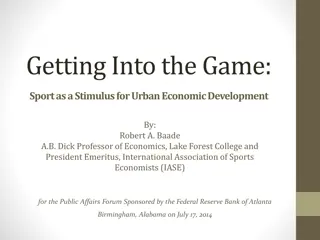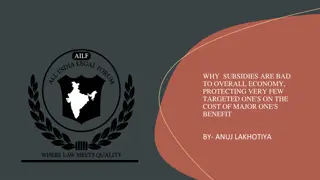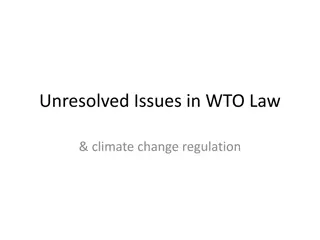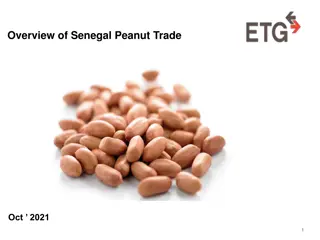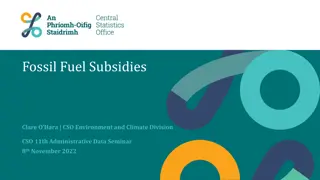Enhancing Food Sufficiency Through Agricultural Subsidies in Senegal
Senegal's agricultural sector faces challenges in achieving food sufficiency. The case study explores the effectiveness of agricultural input subsidies as a key instrument. The GOANA initiative aims to address food insecurity through measures like expanding cultivated areas and enhancing access to inputs and equipment. The study focuses on the sustainability, design, and impact of these subsidies.
Uploaded on Oct 09, 2024 | 1 Views
Download Presentation

Please find below an Image/Link to download the presentation.
The content on the website is provided AS IS for your information and personal use only. It may not be sold, licensed, or shared on other websites without obtaining consent from the author.If you encounter any issues during the download, it is possible that the publisher has removed the file from their server.
You are allowed to download the files provided on this website for personal or commercial use, subject to the condition that they are used lawfully. All files are the property of their respective owners.
The content on the website is provided AS IS for your information and personal use only. It may not be sold, licensed, or shared on other websites without obtaining consent from the author.
E N D
Presentation Transcript
Choice of Optimal Instruments for Boosting Food Sufficiency the case of agricultural input subsidies in Senegal CABRI SECTOR DIALOGUE: SENEGAL CASE STUDY CABRI SECTOR DIALOGUE Dakar, Senegal July, 2013
Title of Slide to go Here Subtitle to go here Presentation Outline Introduction Overview of Senegal s Agricultural Sector Government and Development Partner Spending on Agriculture between 2002 - 2009 Government Instruments of Agricultural Support along the Production Chain Implementation of Agriculture Subsidies Impact of Agriculture Subsidies: Micro Evidence from Sample Survey AFRICAN CENTER FOR ECONOMIC TRANSFORMATION AFRICAN CENTER FOR ECONOMIC TRANSFORMATION
Title of Slide to go Here Subtitle to go here Introduction Senegal s Food Insecurity led to an unprecedented food crisis in 2007 Government of Senegal (GoS) Response in 2008: GOANA or Grande Offensive Agricole pour la Nourriture et l Abondance (Great Agricultural Offensive for Food and Abundance) with an estimated total cost of FCFA345 billion ($803.85 million) Aim of GOANA: To put Senegal on a pathway to attain food sufficiency by 2015 3 Broad Measures the expansion of the cultivated areas with a particular focus on irrigated land, the diversification of staples, namely corn, cassava, rice, and greater access to agricultural inputs and equipment. CASE STUDY FOCUS: Access to agricultural inputs and equipment Specifically 3 questions: Are input subsidies fiscally sustainable as an instrument for food sufficiency? Is the subsidy program well structured (design, targeting, risk etc)? Do the observed results/impact justify the cost (value for money)? AFRICAN CENTER FOR ECONOMIC TRANSFORMATION AFRICAN CENTER FOR ECONOMIC TRANSFORMATION
Title of Slide to go Here Subtitle to go here Overview of Senegal s Agricultural Sector Plays a Crucial Role in economic and social context; Employs a large majority of the labor force Dominated (95%) by subsistence farming Only 5% agribusiness (horticulture and arboriculture) and industrial agriculture (groundnut and cotton), for urban market Dakar and export markets Heavily dependent on Sahelien region rain and climatic conditions High Food Insecurity Chronic deficits of the commodity trade balance Heavily reliant on foreign supply thus vulnerable to external market shock, price hikes Malnutrition affects 21% of total population (3 mill) Absolute rise in the # of malnourished AFRICAN CENTER FOR ECONOMIC TRANSFORMATION AFRICAN CENTER FOR ECONOMIC TRANSFORMATION
Title of Slide to go Here Subtitle to go here Profile of Senegal s Agricultural Sector Main Agricultural Commodities: Groundnuts, rice and millet made up 40% total agri produce in 2011 But declining production of cash crops Agricultural Growth very volatile: Between 2001 and 2011 range -22% (2002) and 20.5% (2003) 2011 was the most recent contraction of agriculture Low productivity 600000 500000 400000 300000 200000 100000 Production (in $1,000) 0 Production (in MT) 70.00 60.00 Source: FAO Stat (online) 50.00 Agricultural value added (% of GDP) 40.00 Manufacturing value added (% of GDP) 30.00 Economic growth fueled mostly by growth in the service sector vs. mainly stagnant agric sector 20.00 Services etc value added (% of GDP) 10.00 0.00 Source: World Development Indicators (Online) AFRICAN CENTER FOR ECONOMIC TRANSFORMATION AFRICAN CENTER FOR ECONOMIC TRANSFORMATION
Government and Development Partner Spending on Title of Slide to go Here Subtitle to go here Agriculture have risen significantly 2002 - 2009 180000 GoS Spending Spending has risen significantly 2002-09 3 fold increase FCFA 55.1bn 170.2bn 160000 140000 120000 Donors 100000 Structural shift towards more pro-cyclical capital spending since 2004 During budget crisis, capital spending decreased by 40% while non-captial spending continued to rise BUT Spending falls short of Maputo Declaration GoS has only slightly crossed the threshold in two years (2007 and 2009) Between 2002 2009 Avg share was lower than commitment 9.7% Investment 80000 Non-salary 60000 Salary 40000 20000 0 2002 2003 2004 2005 2006 2007 2008 2009 Source: DAPS, Ministry of Agriculture, Senegal Development Partner Spending Spending has risen significantly 2002 09 74% increase FCFA 40.7bn 70bn 41% of total agric spending More reliable source even during the financial crises; only marginal effects, rising since 2005 AFRICAN CENTER FOR ECONOMIC TRANSFORMATION AFRICAN CENTER FOR ECONOMIC TRANSFORMATION
Title of Slide to go Here Subtitle to go here the Production Chain (1) Instruments of Agricultural Support along Pre-Production Stage Improved accessibility to inputs Expand growing capacity Encourage adoption of new technology Improved food security Land availability (land banks) Targeted input subsidy (voucher) programs oSeeds oFertilizer oEquipment Subsidized credit scheme Common infrastructure o Roads, Irrigation Farmers Association unions and cooperatives. Private sector wholesalers and retailers, dealers network Production Stage Post Production Improved incomes, Improve food availability and access Expand output Minimize cost, Improved quality, Enhance production technology Objectives Instruments Disease control Extension services Technological services Quality control Farmers Associations unions, cooperatives Post- harvest services Storage facilities Transportation (access to markets) Price support Food supply programs AFRICAN CENTER FOR ECONOMIC TRANSFORMATION AFRICAN CENTER FOR ECONOMIC TRANSFORMATION
Title of Slide to go Here Subtitle to go here the Production Chain (2) Instruments of Agricultural Support along Pre-Production Stage Production Stage Post Production Fiscal Needs Recurrent government support through budget by way of subsidies needs to be funded on annual basis. Risk of expenditure substitution by farmers who apply same amount of seeds and fertilizers but enjoy cost-saving. Administrative cost of managing and monitoring subsidy programs Recurrent expenditure for disease control and extension services largely through payroll and administrative spending in managing program Manpower and skills development costs Cost sharing may compromise program effectiveness Storage facilities and transportation may be one-time capital expenditures Price support schemes may require income buffers Incentives Input subsidy can be targeted to individual farmers on the basis of years of experience, acreage or landholding size, household assets, location, crop type. Incentive compatible for farmers to encourage use of inputs to boost productivity, especially for those who otherwise cannot afford the desired amount of inputs Incentive compatible for farmers because of the positive externalities in the provision of these services with high lump-sum fixed costs for individual farmers. Disease control is a beneficial public good. All farmers benefit proportionate to size of harvest and productivity AFRICAN CENTER FOR ECONOMIC TRANSFORMATION AFRICAN CENTER FOR ECONOMIC TRANSFORMATION
Title of Slide to go Here Subtitle to go here the Production Chain (3) Instruments of Agricultural Support along Pre-Production Stage Production Stage Post Production Risks Borne largely by government depending on the nature of the subsidy schemes Inputs may be transferable or re-sold in different markets while applying less than desired amount, especially in the case of fertilizers Susceptible to leakage inputs may be diverted and sold to farmers and traders in different location or for different crops not covered by subsidy scheme Minimum risks to both farmers and government since program is centrally delivered in kind and is non-transferable Minimum risks to farmers and government since program is centrally delivered in kind, non-transferable. May share maintenance costs. Price support risk is borne solely by government BUT PROBLEM OF LEAKAGES AFRICAN CENTER FOR ECONOMIC TRANSFORMATION AFRICAN CENTER FOR ECONOMIC TRANSFORMATION
Title of Slide to go Here Subtitle to go here Subsidies in Senegal The Implementation of Agriculture Major reforms to reach food sufficiency Great Push Forward for Agriculture, Food and Abundance or Grande Offensive pour l Agriculture, la Nutrition et l Abondance (GOANA) Return to Agriculture or Retour vers l Agriculture (REVA) designed to promote agriculture and tackle rural migration and emigration Main Instruments for Agricultural Support: Based on assumption that these are the major constraints to production Supply of more agricultural equipment Subsidized seeds to farmers Making additional land available to farmers at no charge But subsidies have been the main component of GoS support to agriculture 2001 - 2011 Subsidies increased from a meager FCFA 75 million in 2001 to FCFA 36.3 billion in 2011, a 484-fold nominal increase in this 10-year period Fertilizers were the main target (30%) of the total subsidy amounts 2011/2012 campaign FCFA 30.9 billion was necessary to subsidize various agricultural inputs AFRICAN CENTER FOR ECONOMIC TRANSFORMATION AFRICAN CENTER FOR ECONOMIC TRANSFORMATION
Title of Slide to go Here Subtitle to go here Sample Survey Impact of Subsidies: Micro-evidence from In June 2013, a team of surveyors interviewed 183 farmers who received the fertilizer subsidy and those that did not in the agricultural area of the Senegalese River valley. Characteristics of Sample Scattered over three rural communities Mostly small-scale, subsistent farmers who were owners of the land for three decades Access to some form of irrigation, low access to finance, limited access to storage facilities Diversified Farming Activity (Rice (mostly 66%), onions and tomatoes) Mostly limited education (53.3%) (barely attained primary or secondary level education (48.9%) Mostly part of farmers unions (85.5%) Extent of Government Support Count 183 92 179 92 Average 0.5 117.6 245.4 82.1 Min 0 10 26 5 Max 1 500 500 100 Subsidy beneficiaries Subsidy on price (FCFA) Price (FCFA) Subsidy: share of price (%) Focus on Rice producers AFRICAN CENTER FOR ECONOMIC TRANSFORMATION AFRICAN CENTER FOR ECONOMIC TRANSFORMATION
Title of Slide to go Here Subtitle to go here Farmer Productivity Relationship between Subsidy and Rice Variables No Fertilizer Fertilizer and No Subsidy 3.5 94 3 411 1.2 Fertilizer and Subsidy 3.4 92 4.1 572 1.4 60% Similar profiles but Notable difference between the quantity of fertilizers used and productivity. Farmers who used fertilizers and received a subsidy are associated with higher use of fertilizers and have higher rice yield. BUT RELATIONSHIP IS NOT CAUSALITY Years of education % of FBO member Productivity (t/ha) Quantity of fertilizer used Land size Subsidy as share of price 5 100 3.2 0 0.7 Source: Survey data, June 2013 6 4 A comparison between the share of fertilizer subsidy recipients and the natural logarithm of rice productivity suggests that: the difference in productivity between producers who receive 100% subsidy and those that receive 10% is negligible Productivity 2 0 BUT PROBLEM OF LEAKAGES -2 0 20 40 60 80 100 AFRICAN CENTER FOR ECONOMIC TRANSFORMATION AFRICAN CENTER FOR ECONOMIC TRANSFORMATION Subsidy_share
Title of Slide to go Here Subtitle to go here Discussion Questions Are input subsidies fiscally sustainable as an instrument for food sufficiency? Is the subsidy program well structured (design, targeting, risk etc)? Do the observed results/impact justify the cost (value for money)? Leakages/Spillovers???? AFRICAN CENTER FOR ECONOMIC TRANSFORMATION AFRICAN CENTER FOR ECONOMIC TRANSFORMATION
Title of Slide to go Here Subtitle to go here AFRICAN CENTER FOR ECONOMIC TRANSFORMATION
